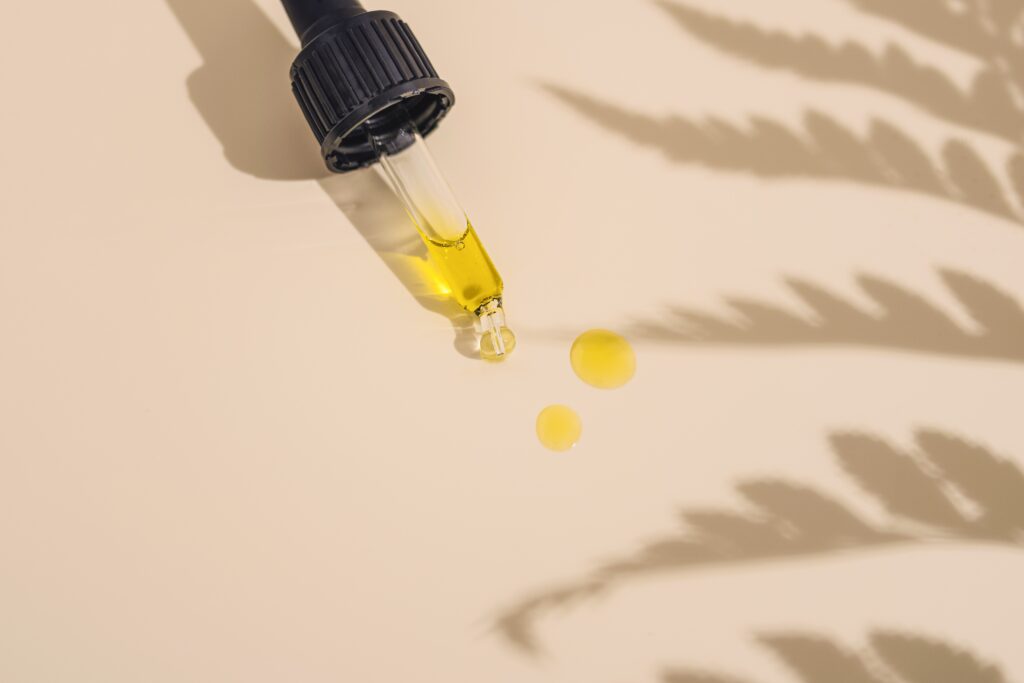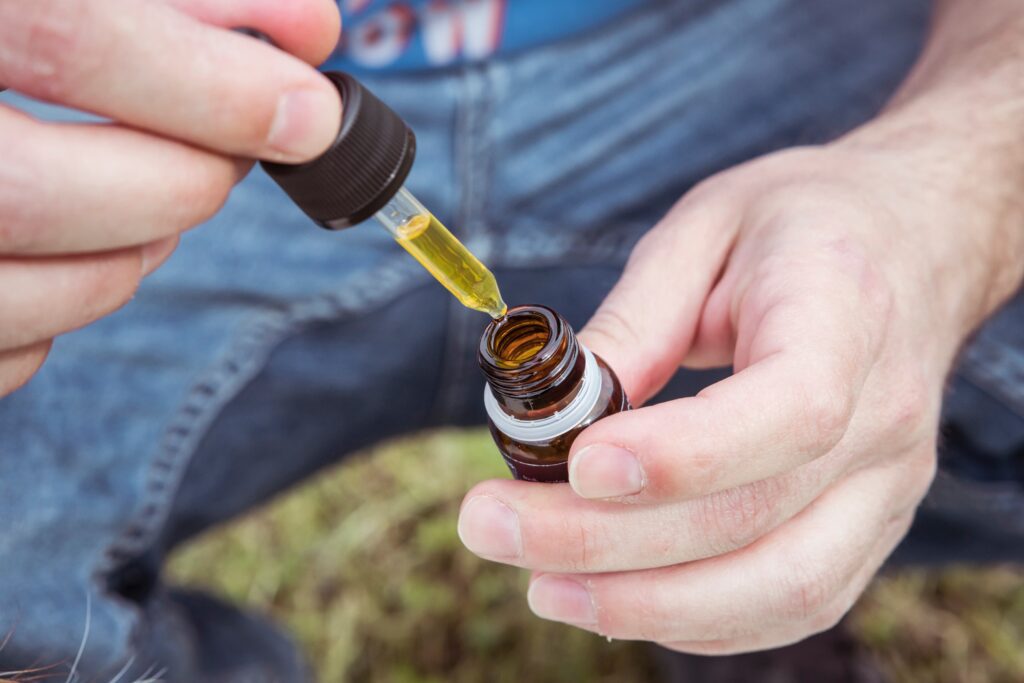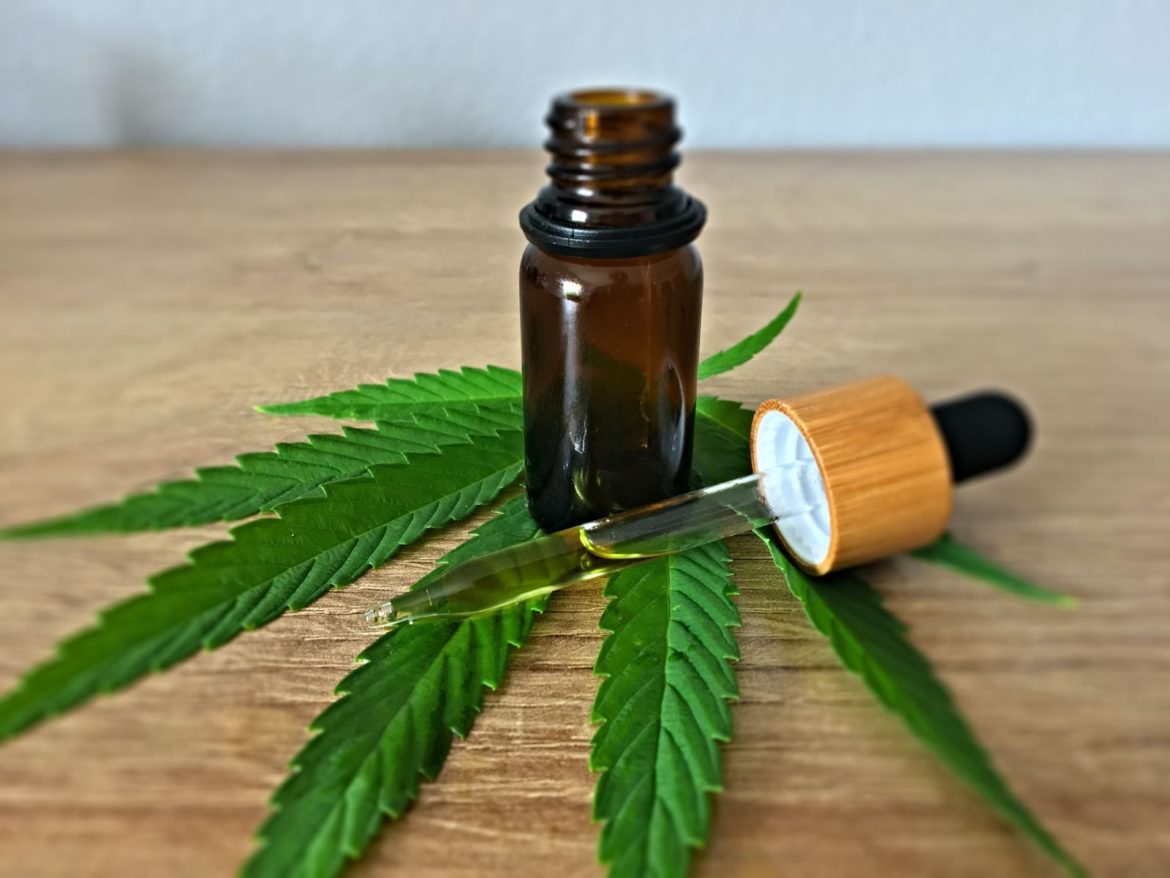It’s never as simple as just “CBD.” Cannabinoids are a vast landscape and can come from any number of plants, including cannabis and hemp. CBD oil comes in a full-spectrum, broad-spectrum, or CBD isolate product. Other ingredients, like carrier oils, essential oils, terpenes, and flavors can be added in. Every company has a signature formula, their own “secret sauce,” if you will.
CBD usually comes in oil or tincture, but that’s far from its only form. You’ll find it in topicals like lotions, lip balms, skincare, toothpaste, and even shampoo. It’s infused into juice drinks, peanut butter, cookies, and brownies. There are restaurateurs even drizzling CBD-infused olive oil on pizza.
So, what is full-spectrum CBD? What does the term “full-spectrum” refer to? What makes it better or worse than other kinds of CBD? Is it legal to use? If you’re new to the world of CBD, you probably have a lot of pressing questions. We have answers.
What is full-spectrum CBD?
Full-spectrum CBD is an oil derived from hemp or cannabis plants. The term “full-spectrum” means that the full spectrum of the plant’s cannabinoids, phytonutrients, flavonoids, fatty acids, waxes, terpenes, and THC are allowed to remain in the oil. It’s the least processed CBD oil available. It’s more or less the same thing as juicing the plant and serving it raw.
There are two different kinds of full-spectrum CBD. One is made from hemp, and one is made from cannabis. The difference between hemp and cannabis is the amount of THC in each plant. Hemp is cannabis sativa that has been bred to have the absolute minimum amount of THC.
Full-spectrum CBD derived from weed
Full-spectrum CBD produced from cannabis is available in medical and adult-use dispensaries. Cannabis produces over 100 different cannabinoids; THC and CBD are just two of them. Every grower produces hundreds of different phenotypes of prized strains, and therefore, they all have different balances of terpenes and cannabinoids to contribute. If companies are attempting to appeal to people who are looking for the benefits of CBD, they often choose to cultivate their highest CBD strains.
How much THC you’re going to get depends on the company. There’s something for everybody. If you’re looking for a CBD oil that’s under 5% THC, you’ll find options in the marketplace. If you’re looking to head in the high-THC direction, you can find a tincture or oil concentrated above 60% THC. If you’re a seasoned smoker, you’ll find your sweet spot somewhere in the middle. Just shop according to your personal preference and tolerance.
Full-spectrum CBD from hemp
Just like the cannabis plant, a wide array of cannabinoids exist naturally in hemp. There’s no way to completely breed THC out. The current hemp production law designates hemp as any cannabis plant containing a maximum of 0.3% THC by dry weight. In short, hemp is a type of cannabis plant that has been bred not for its THC content but instead for other uses like textiles, fiber, and CBD oil. Thanks to the passage of the 2018 Farm Bill, a lot is riding on the 0.3% figure. If plants test at a higher THC percentage, the entire batch of hemp may be destroyed.
Farmers can grow hemp for hemp seed oil, protein powder, paper, clothing, and even sustainable fuel as long as they keep their plants as low in THC as possible. Hemp is what gives the CBD industry so much room for growth, even in states that are dragging their heels to legalize adult-use or medical cannabis.
Although the hemp plant sacrifices almost all of its THC, it retains all of its other compounds. That’s why hemp extract, or hemp-based CBD, is becoming available in grocery stores. It’s legal on a federal level and legal (in one form or another) in every state, making it the most popular plant for CBD production.
Why is full-spectrum CBD different from broad-spectrum?
Full-spectrum CBD is different from all other kinds of CBD because it’s the only variety that can include THC. The widely legal and highly available CBD you might find at the health food store or local drugstore is made from hemp. Hemp-derived products contain less than 0.3%THC, and that’s their most important distinction.
The legal limit of THC for these CBD products is 0.3%, but most CBD products contain even less, 0% THC. You’re unlikely to find a full spectrum hemp tincture that actually contains a significant amount of THC. The truth is that regulated hemp companies are extremely cautious to abide by the law. Growing plants that exceed 0.3% can come with legal consequences and even forced destruction of hemp plants. Companies prefer to play it safe.
This “play it safe” approach usually means that hemp CBD tinctures contain less than half of the maximum amount of THC. Hemp companies are very diligent about staying on the right side of the law. Most reputable hemp companies send a sample from each batch they produce to a third-party lab. The lab analyzes the contents of the final product and creates a report that includes THC content. In many cases, you’ll see that even full-spectrum products hardly contain any detectable THC.
Where all cannabis is recreationally legal and in states where medical cannabis is legal, you’ll find high-CBD and THC oils. The removal of the 0.3% threshold in these circumstances allows producers to make CBD oils that provide the benefits that come with a higher amount of THC. These THC and CBD full-spectrum oils can allow consumers to catch a buzz, but more often, they are used to offer medical marijuana patients higher efficacy for treating conditions from epilepsy to pain relief.
How to use full-spectrum CBD
Full-spectrum CBD oil is best enjoyed in the form of a sublingual tincture. People who use full-spectrum CBD often have some kind of wellness goal they’d like to meet immediately. When you use a sublingual tincture, you’re allowing the CBD to bypass your digestive system and directly enter your bloodstream. This promotes its effects, like relaxation, reduced inflammation, and reduced anxiety, much sooner.
What is broad-spectrum CBD oil?
Broad-spectrum CBD oil starts as full-spectrum CBD oil. It then undergoes a battery of additional processes to change its makeup, extracting certain compounds. The full-spectrum CBD oil is run through a solvent extractor machine to undergo a process to sort the oil by particle size.
Solvent extraction can be performed in numerous ways, but most companies use something called short path distillation to separate the compounds of the plant extract. They use a solvent, a liquid chemical, to dissolve and capture the THC from the extract, and then they evaporate everything in the machine.
Since it’s been evaporated inside of a machine, the machine is full of trapped gas. Then they condense the gas back into a liquid. The THC and solvent remain as gas and are then tossed from the mixture. The remaining liquid is broad-spectrum CBD.
How to use broad-spectrum CBD
Broad-spectrum CBD is often used in tincture or capsule form. It will deliver most of the same benefits as full-spectrum CBD in the same amount of time, but the impact of the benefits may be different due to the lack of THC in the product. Try out the two types and feel their differences for yourself.
What are the benefits of broad-spectrum CBD?
The biggest benefit of broad-spectrum CBD is that it’s the best possible compromise for people who don’t want any THC in their products. You’re getting almost all of the benefits of full-spectrum CBD, minus the THC. Other cannabinoids are working in your favor, i.e., the term broad. This is a huge bonus for people who, for one reason or another, cannot have any THC in their system.
It’s very unlikely that broad-spectrum CBD would cause you to fail a drug test. The removal of all detectable THC is a comfort to many people who still fear the stigma of THC or people who work in a field where THC might jeopardize their careers.

How is full-spectrum CBD used?
Full-spectrum CBD can be vaped, used as a sublingual tincture, ingested in a soft gel, gummy, blended into topical skincare products, or incorporated into food and drink. Each form comes with unique advantages and disadvantages.
Vaping full-spectrum CBD
Vaping delivers the benefits of full-spectrum CBD in the fastest and most efficient way. You can take a hit of CBD-infused concentrate vape form, as long as it is clean and doesn’t contain any propylene glycol or Vitamin E Acetate. You can also smoke whole CBD flower and immediately start to feel the CBD getting to work. People who smoke cannabis are likely to be comfortable with this method. People who don’t may have some reservations about inhaling things.
It is inherently true that when you combust plant matter, the smoke can damage your lungs. If you choose to smoke CBD flower, do so at your own risk. It’s also worth mentioning that when it comes to something you’re inhaling, you don’t want to take someone’s word for it that you’re actually getting what they say you’re getting. Don’t purchase unlicensed market CBD, but find a reputable brand so you know exactly what you’re getting.
If you’re familiar with the pros and cons of vaping and you’ve come to the conclusion that vaping is a good fit for you, be careful who you buy from. Thankfully, there are many trustworthy CBD brands on the market today.
Trying to save a few bucks by purchasing CBD from a convenience store is not the move. The easiest way is to buy CBD online directly from a brand you trust and get it mailed to you. Buy your CBD cartridges from a reputable supplier and choose a brand that’s transparent about their ingredients, and provides third-party lab analysis reports (which many do these days). A few trustworthy brands that are popular in today’s CBD market include CBD Living, Saint Jane, Juna, cbdMD, CBDistillery, and Charlotte’s Web.
Full-spectrum CBD sublingual tinctures
Full-spectrum sublingual CBD tinctures are safe and effective. You don’t have to inhale anything, and you’re reducing the waiting period that digesting the CBD would take to kick in. Sublingual tinctures don’t work with your digestive system. As they are absorbed into the bloodstream when you place the drops under your tongue, sublingual bypass the liver entirely.
The tissue under your tongue is very thin. It can absorb small particles and deliver them directly to your bloodstream at an efficient rate. That’s why so many anti-nausea medications come in dissolvable tablets. Your body can absorb them and use them right away when they enter via the sublingual route.
Taking full-spectrum CBD softgels, capsules, and gummies
Health-conscious people who take CBD may prefer it in the form of soft gels, capsules, or gummies. This form is also comforting since it mimics the supplements and vitamins they’re used to. If you already have a routine that involves taking daily supplements, using CBD in one of these forms may be easier for you. You’re less likely to forget to take your CBD if it easily assimilates into your ritual.
The only differentiation between soft gels, capsules, and gummies is that they need to pass through your digestive system first. Anything that passes through your digestive system is broken apart and filtered before it hits your bloodstream. Your stomach and liver go to work on the CBD, changing it before it becomes usable to your body.
This may reduce the potency of your CBD, but it does also last longer. It takes a while before your CBD can get to work. If you’re taking it for overall wellness or general endocannabinoid system support, this waiting period probably won’t bother you much.
Softgels, capsules, and gummies are valuable forms of CBD, but only if they’ll work with your wellness goals. If they’re going to hinder you more than they help you, you’re better off going with sublingual CBD.
Using full-spectrum CBD topicals, creams, and body oils
CBD blended into topicals is designed to help relieve aches and pains from the surface. It works the same way muscle rubs work, and it also contains many of the same ingredients. You’ll find CBD topicals formulated with ingredients like menthol, arnica, and emu oil.
These products are great for when you need a muscle rub. If your shoulders and neck are sore or strained from an all-nighter at your desk, if you went hard at the gym, go ahead and grab a topical.
The biggest thing to remember with topicals is that they don’t reach the endocannabinoid system, only the skin, and muscle tissue. You’ll need to use a high milligram potency in topicals to really experience their benefits. Also, it is recommended to use them in conjunction with another form of CBD that enters your bloodstream if you really want to experience CBD’s full effects. Topical forms are beneficial for your skin but more supplementary than primary to your overall endocannabinoid system’s health.

What can CBD be used for?
CBD is used for a lot of things. People use CBD to relax, support workout recovery, get better sleep, and even promote balanced mental health. Research shows that CBD reduces inflammation, which helps with a wide array of inflammatory issues. Another trusted 2018 review shows that CBD is effective for pain management. Then, there is a notable 2015 study that found CBD is helpful in reducing anxiety.
There are other studies that back up CBD as an effective treatment for seizure disorders, like epilepsy. Epidiolex, which is prescribed for epilepsy, is, in fact, the only CBD product on the market that has been approved by the FDA. Always talk to your doctor before using CBD for any ailment, but there are many promising studies coming out still that show the versatility of cannabinoids for our health.
What are the benefits of full-spectrum CBD?
Full-spectrum CBD’s benefits over other kinds of CBD is the inclusion of the THC, CBN, CBG, in addition to other cannabinoids and compounds. Keep in mind that THC exists in microscopic amounts in all regulated hemp products, but other CBD wellness products formulated with higher THC concentrations will obviously boast a more noticeable THC effect.
Full-spectrum CBD is packed with fatty acids, terpenes, phytonutrients, cannabinoids, and THC. Hemp-derived CBD has less than 0.3% of THC. Cannabis-derived CBD can have a little (or a whole lot) more. How much THC the product contains isn’t specifically what matters. What matters the most in triggering the benefits induced by the entourage effect.
The biggest benefit of full-spectrum CBD is that it’s giving you the plant in its entirety. All of the terpenes, cannabinoids, and compounds have lived together in that plant since it started to grow. They worked in synergy to keep the plant healthy, and they naturally boost each other’s effects. They’re working together as a dream team.
Thanks to the entourage effect, full-spectrum CBD is the strongest type you can buy. The whole entourage of compounds enters your body and continues to work as a team. They’re stronger together, and therefore, they’re stronger in your bloodstream.
When every cannabinoid and compound reaches your endocannabinoid system, they’re able to work efficiently to deliver overall wellness benefits. Full-spectrum CBD offers a mental and physical boost to your body, promoting truly balanced health.
Removing compounds like THC or other cannabinoids breaks that chain. It eliminates their ability to work in familiar harmony and therefore limits the number of benefits you’ll experience from your CBD. That’s why full-spectrum CBD is always your best bet.
Can full-spectrum CBD get you high?
Full-spectrum CBD from hemp will not get you high. You won’t catch any kind of buzz from less than 0.3% THC. Full-spectrum CBD and THC oil made from cannabis, sold at a medical or adult-use dispensary or available online through Emjay, can get you as high, depending on the number of milligrams of THC. You can choose a product with your desired level of THC.
Are there any side effects of CBD?
CBD is usually well-tolerated by everyone, even with daily use at high concentrations. Side effects are rare, but some people have reported dry mouth, nausea, fatigue, drowsiness, and reduced appetite. Some people report side effects based on the carrier oil or other ingredients in their CBD product, so be sure to check the CBD oil’s ingredients list to make sure every other item in it is personally safe for your consumption.
CBD is generally very safe. Side effects with other medications, like blood thinners, are rare but possible. Talk to your doctor before you start using CBD. Most doctors are beginning to better understand the endocannabinoid system and come around to the use of CBD as a wellness supplement. They will be able to tell you if there’s any reason you shouldn’t take CBD or if you should limit the amount you’re taking. Asking is always the best strategy.
How to choose a CBD product that’s right for you
You have to ask yourself a few important things before you pick up your first CBD product. To THC or not to THC? That is the question. You can go with a broad-spectrum CBD, a full-spectrum hemp CBD product to get the entourage effect without the high, or a cannabis-derived CBD and THC product that will get you high and support your wellness at the same time. Test each variety of CBD out for yourself. Each of them work, but the entourage effect will increase efficacy.
Emjay has everything from CBD wellness products with zero THC to highly-concentrated THC and CBD topical products. Best of all, we’re willing to deliver. Your journey to CBD wellness has never been easier. Our wide selection of products features something for everyone. If you’re looking to reduce inflammation, anxiety, and pain, we feel you. If you’re looking to get lit, we also feel you, and we’re here to help.
